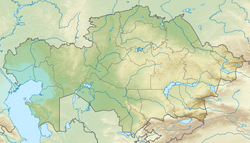1911 Kebin earthquake
| Date | 3 January 1911 |
|---|---|
| Magnitude | 7.7 Mw |
| Depth | 25 km (16 mi) |
| Epicenter | 43°30′N 77°30′E / 43.5°N 77.5°ECoordinates: 43°30′N 77°30′E / 43.5°N 77.5°E |
| Areas affected | Kazakhstan, Kyrgyzstan |
| Total damage | Severe |
| Max. intensity | X (Extreme) |
| Casualties | 452 |
The 1911 Kebin earthquake, or Chon-Kemin earthquake, struck Russian Turkestan on 3 January. Registering at a 7.7 magnitude, it killed 452 people, destroyed more than 770 buildings (which was almost all of the city) in Almaty, Kazakhstan, and resulted in 125 miles (201 km) of surface faulting in the valleys of Chon–Kemin, Chilik and Chon-Aksu.
Most of the region's inhabitants lived in yurts, which are relatively resistant to earthquakes and unlikely to cause deaths even if they do collapse. The greatest damage and most of the casualties resulted from landslides triggered by the earthquake, with 452 people killed and another 740 people injured. Nearly 1,100 houses and 4,545 yurts were destroyed by the earthquake and the resulting landslides.
The Tien Shan mountains form part of the broad zone of deformation associated with the continuing collision between the Indian Plate and the Eurasian Plate. In the region around Issyk Kul, the tectonic regime is a combination of thrusting and sinistral strike-slip. The lake is a depression bounded to both north and south by opposite verging thrust faults, while the major Chon-Kemin–Chilik strike-slip fault runs along the linear valleys to the north.
In the Chong-Kemin and Chilik valleys, and on the shoreline of Issyk Kul, a complex zone of surface ruptures was identified by fieldwork immediately following the earthquake. Two main zones of rupture were noted, one complex zone along the Chon-Kemin and Chilik valleys, the other along the Chon-Aksu valley.
This complex zone of ruptures has four main segments: the 20 km long Dzhil'-Aryk, the 62 km long Lower Chon-Kemin, south side, the 40 km long Lower Chon-Kemin, north side and the 66 km long Upper Chon-Kemin-Chilik zone. The Dzhil'-Aryk segment shows evidence of reverse faulting on a south-dipping fault plane, with no clear evidence of lateral movement. The sense of displacement along the rest of the near-vertical Chon-Kemin and Chilik rupture zone was dominantly of sinistral (left lateral) strike-slip with minor amounts of reverse faulting, with between one and three metres of vertical displacement. Left-lateral displacements of up to 40 m recognised from the offset of river channels, represent cumulative displacements and no separate estimates have been obtained for the 1911 event.
...
Wikipedia

